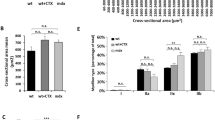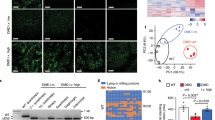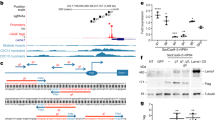Abstract
The electrotransfer of naked DNA has recently been adapted to the transduction of skeletal muscle fibers. We investigated the short- and long-term efficacy of this methodology in wild-type animals and in mouse models of congenital muscular dystrophy (dy/dy, dy2J/dy2J), or Duchenne muscular dystrophy (mdx/mdx). Using a reporter construct, the short-term efficacy of fiber transduction reached 40% and was similar in wild-type, dy/dy and dy2J/dy2J animals, indicating that ongoing muscle fibrosis was not a major obstacle to the electrotransfer-mediated gene transfer. Although the complete rejection of transduced fibers was observed within 3 weeks in the absence of immunosuppression, the persistency was prolonged over 10 weeks when transient or continuous immunosuppressive regimens were used. Using therapeutic plasmids, we demonstrated that electrotransfer also allowed the transduction of large constructs encoding the laminin α2 chain in dy/dy mouse, or a chimeric dystrophin-EGFP protein in mdx/mdx mouse. The correct sarcolemmal localization of these structural proteins demonstrated the functional relevance of their expression in vivo, with a diffusion domain estimated to be 300 to 500 μm. However, degeneration–regeneration events hampered the long-term stability of transduced fibers. Given its efficacy for naked DNA transfer in these models of muscular dystrophies, and despite some limitations, gene electrotransfer methodology should be further explored as a potential avenue for treatment of muscular dystrophies.
This is a preview of subscription content, access via your institution
Access options
Subscribe to this journal
Receive 12 print issues and online access
$259.00 per year
only $21.58 per issue
Buy this article
- Purchase on Springer Link
- Instant access to full article PDF
Prices may be subject to local taxes which are calculated during checkout







Similar content being viewed by others
References
Hoffman EP, Brown RH, Kunkel LM . Dystrophin: the protein product of the Duchenne muscular dystrophy locus Cell 1987 51: 919–928
Bulfield G, Siller WG, Wight PAL, Moore KJ . X-chromosome-linked muscular dystrophy (mdx) in the mouse Proc Natl Acad Sci USA 1984 81: 1189–1192
Sicinski P et al. The molecular basis of muscular dystrophy in the mdx mouse: a point mutation Science 1989 244: 1578–1579
Michelson AM, Russell ES, Harman PJ . Dystrophia muscularis: a hereditary primary myopathy in the house mouse Proc Natl Acad Sci USA 1955 41: 1079–1084
Meier H, Southard JL . Muscular dystrophy in the mouse caused by an allele at the dy locus Life Sci 1970 9: 137–144
Arahata A et al. Laminin in animal models for muscular dystrophy. Defect of laminin M in skeletal and cardiac muscles and peripheral nerve of the homozygous dystrophic dy/dy mice Proc Japan Acad 1993 69: 259–264
Xu H et al. Defective muscle basement membrane and lack of M-laminin in the dystrophic dy/dy mouse Proc Natl Acad Sci USA 1994 91: 5572–5576
Sunada Y et al. Deficiency of merosin in dystrophic dy mice and genetic linkage of laminin M chain gene to dy locus J Biol Chem 1994 269: 13729–13732
Xu H, Wu XR, Wewer UM, Engvall E . Murine muscular dystrophy caused by a mutation in the laminin α2 (Lama2) gene Nat Genet 1994 8: 297–302
Sunada Y et al. Identification of a novel mutant transcript of laminin α2 chain gene responsible for muscular dystrophy and dysmyelination in dy2J/dy2J mice Hum Molec Genet 1995 4: 1055–1061
Guicheney P et al. Genetics of laminin α2 chain (or merosin) deficient congenital muscular dystrophies: from identification of mutations to prenatal diagnosis Neuromusc Disord 1997 7: 187–190
Wolff JA et al. Direct gene transfer into mouse muscle in vivo Science 1990 247: 1465–1468
Davis HL, Brazolot Millan CL, Watkins SC . Immune-mediated destruction of transfected muscle fibers after direct gene transfer with antigen-expressing plasmid DNA Gene Therapy 1997 4: 181–188
Doh SG et al. Spatial-temporal patterns of gene expression in mouse skeletal muscle after injection of lacZ plasmid DNA Gene Therapy 1997 4: 648–663
McMahon JM et al. Inflammatory responses following direct injection of plasmid DNA into skeletal muscle Gene Therapy 1998 5: 1283–1290
Davis HL et al. DNA-mediated immunization in mice induces a potent MHC class I-restricted cytotoxic T lymphocyte response to the hepatitis B envelope protein Hum Gene Ther 1995 6: 1447–1456
Aihara H, Miyazaki JI . Gene transfer into muscle by electroporation in vivo Nat Biotech 1998 16: 867–870
Mir L, Bureau M, Rangara R, Schwartz B, Scherman D . Long-term, high level in vivo gene expression after electric pulse-mediated gene transfer into skeletal muscle CR Acad Sci 1998 321: 893–899
Mir LM et al. High efficiency gene transfer into skeletal muscle mediated by electric pulses Proc Natl Acad Sci USA 1999 96: 4262–4267
Mathiesen I . Electropermeabilization of skeletal muscle enhances gene transfer in vivo Gene Therapy 1999 6: 508–514
Rizzuto G et al. Efficient and regulated erythropoietin production by naked DNA injection and muscle electroportaion Proc Natl Acad Sci USA 1999 96: 6417–6422
Vicat JM et al. Muscle transfection by electroporation with high-voltage and short-pulse currents provides high-level and long-lasting gene expression Hum Gene Ther 2000 11: 909–916
Bettan M et al. High level protein secretion into blood circulation after electric-pulse mediated gene transfer into skeletal muscle Mol Ther 2000 2: 204–210
Bureau MF et al. Importance of association between permeabilization and electrophoretic forces for intramuscular DNA electrotransfer Biochem Biophys Acta 2000 1474: 353–359
Pastoret C, Sebille A . mdx mice show progressive weakness and muscle deterioration with age J Neurol Sci 1995 129: 97–105
Hoffman EP, Morgan JE, Watkins SC, Partridge TA . Somatic reversion/suppression of the mouse mdx phenotype in vivo J Neurol Sci 1990 99: 9–25
Deconinck N et al. Functional protection of dystrophic mouse (mdx) muscles after adenovirus-mediated transfer of a dystrophin minigene Proc Natl Acad Sci USA 1996 93: 3570–3574
Leivo I, Engvall E . Merosin, a protein specific for basement membranes of Schwann cells, striated muscle, and trophoblast, is expressed late in nerve and muscle development Proc Natl Acad Sci USA 1988 85: 1544–1548
Colognato H, Winkelmann DA, Yurchenco PD . Laminin polymerization induces a receptor-cytoskeleton network J Cell Biol 1999 145: 619–631
Pearce GW, Walton JN . A histological study of muscle from the Bar Harbor strain of dystrophic mice J Path Bact 1963 86: 25–33
MacPike AD, Meier H . Comparison of dy and dy2J, two alleles expressing forms of muscular dystrophy in the mouse Proc Soc Exp Biol Med 1976 151: 670–672
Meier H, MacPike AD . Myopathies caused by three mutations of the mouse J Heredity 1977 68: 383–385
Vachon PH et al. Merosin and laminin in myogenesis; specific requirement for merosin in myotube stability and survival J Cell Biol 1996 134: 1483–1498
Kuang W, Xu H, Vilquin JT, Engvall E . Activation of the lama2 gene in muscle regeneration: abortive regeneration in laminin α2-deficiency Lab Invest 1999 79: 1601–1613
Lefaucheur JP, Sebille A . The cellular events of injured muscle regeneration depend on the nature of the injury Neuromusc Disord 1995 5: 501–509
Guérette B et al. Lymphocyte infiltration following allo- and xenomyoblast transplantation in mdx mice Muscle Nerve 1995 18: 39–51
Vilquin JT et al. FK506 immunosuppression to control the immune reactions triggered by first generation adenovirus-mediated gene transfer Hum Gene Ther 1995 6: 1391–1401
Kinoshita I et al. Very efficient myoblast allotransplantation in mice under FK506 immunosuppression Muscle Nerve 1994 17: 1407–1415
Guérette B et al. Increased interferon-gamma mRNA expression following alloincompatible myoblast transplantation is inhibited by FK506 Muscle Nerve 1996 19: 829–835
Christ M et al. Gene therapy with recombinant adenovirus vectors: evaluation of the host immune response Immunol Lett 1997 57: 19–25
Lochmuller H et al. Transient immunosuppression by FK506 permits a sustained high-level dystrophin expression after adenovirus-mediated dystrophin minigene transfer to skeletal muscles of adult dystrophic (mdx) mice Gene Therapy 1996 3: 706–716
Ilan Y et al. Transient immunosuppression with FK506 permits long-term expression of therapeutic genes introduced into the liver using recombinant adenoviruses in the rat Hepatology 1997 26: 949–956
Yang L et al. Adenovirus-mediated dystrophin minigene transfer improves muscle strength in adult dystrophic (MDX) mice Gene Therapy 1998 5: 369–379
Potter MA, Chang PL . Review – the use of immunosuppressive agents to prevent neutralizing antibodies against a transgene product Ann NY Acad Sci 1999 875: 159–174
Harris JB, Johnson MA . Further observations on the pathological responses of rat skeletal muscle to toxins isolated from the venom of the Australian tiger snake, Notechis scutatus scutatus Clin Exp Pharmacol Physiol 1978 5: 587–600
Dixon RW, Harris JB . Myotoxic activity of the toxic phospholipase, notexin, from the venom of the Australian tiger snake J Neuropathol Exp Neurol 1996 55: 1230–1237
Whalen RG et al. Expression of myosins isoforms during notexin-induced regeneration of rat soleus muscles Dev Biol 1990 141: 24–40
Sharp NJ et al. Notexin-induced muscle injury in the dog J Neurol Sci 1993 116: 73–81
Budker V et al. The efficient expression of intravascularly delivered DNA in rat muscle Gene Therapy 1998 5: 272–276
Greelish JP et al. Stable restoration of the sarcoglycan complex in dystrophic muscle perfused with histamine and a recombinant adeno-associated viral vector Nat Med 1999 5: 439–443
Huber PE et al. A comparison of shock wave and sinusoidal-focused ultrasound-induced localized transfection of HeLa cells Ultrasound Med Biol 1999 25: 1451–1457
Vilquin JT et al. Evidence of mdx mouse skeletal muscle fragility in vivo by eccentric running exercise Muscle Nerve 1998 21: 567–576
Straub V, Rafael JA, Chamberlain JS, Campbell KP . Animal models for muscular dystrophy show different patterns of sarcolemmal disruption J Cell Biol 1997 139: 375–385
Tocci MJ et al. The immunosuppressant FK506 selectively inhibits expression of early T cell activation genes J Immunol 1989 143: 718–726
Koprak S et al. Depletion of the mature CD4+8− thymocyte subset by FK506 analogs correlates with their immunosuppressive and calcineurin inhibitory activities Transplantation 1996 61: 926–932
Adams DH, Liu Q . FK506 ihibits human lymphocyte migration and the production of lymphcyte chemotactic factors in liver allograft recipients Hepatology 1996 23: 1476–1483
Mori A et al. IL-2-induced IL-5 synthesis, but not proliferation, of human CD4+ T cells is suppressed by FK506 J Immunol 1997 158: 3659–3665
Sasakawa Y et al. KK506 suppresses neutrophil chemoattractant production by peripheral blood mononuclear cells Eur J Pharmacol 2000 403: 281–288
Chapdelaine P et al. Functional EGFP-dystrophin fusion proteins for gene therapy vector development Prot Eng 2000 13: 611–615
Kinoshita I et al. Transplantation of myoblasts from a transgenic mouse overexpressing dystrophin produced only a relatively small increase of dystrophin-positive membrane Muscle Nerve 1998 21: 91–103
Vilquin JT et al. Myoblast transplantations lead to the expression of the laminin α2 chain in normal and dystrophic (dy/dy) mouse muscles Gene Therapy 1999 6: 792–800
Gussoni E, Blau HM, Kunkel LM . The fate of individual myoblasts after transplantation into muscles of DMD patients Nat Med 1997 3: 970–977
Darquet AM et al. Minicircle: an improved DNA molecule for in vitro and in vivo gene transfer Gene Therapy 1999 6: 209–218
Kreiss P et al. Plasmid DNA size does not affect the physicochemical properties of lipoplexes but modulates gene transfer efficiency Nucleic Acids Res 1999 27: 3792–3798
Soubrier F et al. pCOR: a new design of plasmid vectors for nonviral gene therapy Gene Therapy 1999 6: 1482–1488
Gross JG, Morgan JE . Muscle precursor cells injected into irradiated mdx mouse muscle persist after serial injury Muscle Nerve 1999 22: 174–185
Vilquin JT et al. A restriction-based assay for the detection of the dy2J allele in homozygous and heterozygous mice by PCR Neuromusc Disord 2000 10: 59–62
Alameddine H et al. Expression of a recombinant dystrophin in mdx mice using adenovirus vector Neuromusc Disord 1994 4: 193–203
Acknowledgements
We wish to thank Pr Ulla Wewer and Dr Steven Loechel for generously providing the pMER plasmid p941 (pCMV-α2 chain), and Pr Eva Engvall and Dr Annie Cartaud for generously providing anti-mouse laminin α2 chain and anti-dystrophin antibodies, respectively. We thank also Claire Carrion, Isabelle Garcin, Andrée Rouche and André Salmon for their technical assistance. This work was supported by the Institut National de la Santé et de la Recherche Médicale (INSERM), the Association Française contre les Myopathies (AFM), and the European Community (Contract No QLG1–1999–00870).
Author information
Authors and Affiliations
Rights and permissions
About this article
Cite this article
Vilquin, J., Kennel, P., Paturneau-Jouas, M. et al. Electrotransfer of naked DNA in the skeletal muscles of animal models of muscular dystrophies. Gene Ther 8, 1097–1107 (2001). https://doi.org/10.1038/sj.gt.3301484
Received:
Accepted:
Published:
Issue Date:
DOI: https://doi.org/10.1038/sj.gt.3301484
Keywords
This article is cited by
-
Induction of a local muscular dystrophy using electroporation in vivo: an easy tool for screening therapeutics
Scientific Reports (2020)
-
Current Status of Pharmaceutical and Genetic Therapeutic Approaches to Treat DMD
Molecular Therapy (2011)
-
Long term expression of bicistronic vector driven by the FGF-1 IRES in mouse muscle
BMC Biotechnology (2007)
-
Therapeutic restoration of dystrophin expression in Duchenne muscular dystrophy
Journal of Muscle Research and Cell Motility (2006)
-
In vivo NMR imaging evaluation of efficiency and toxicity of gene electrotransfer in rat muscle
Gene Therapy (2005)



